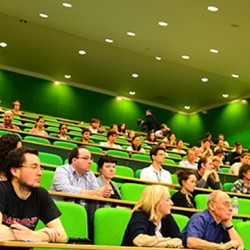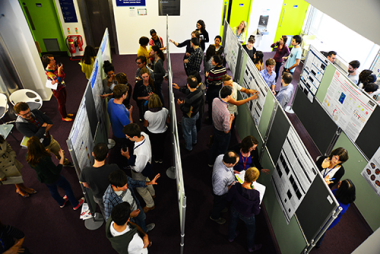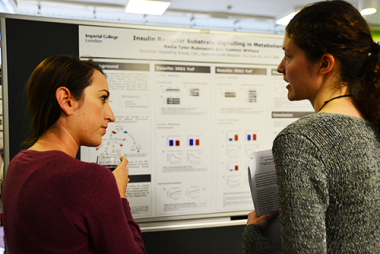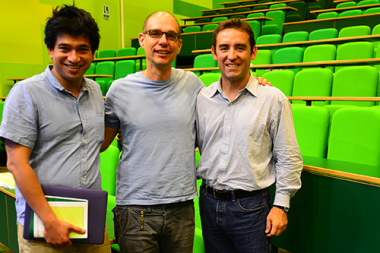 Principal investigators share their findings at the annual retreat
Principal investigators share their findings at the annual retreat
The CSC’s annual retreat got underway yesterday with a talk from laser physicist, Paul French (Imperial College London), who discussed the application of FLIM (Fluorescence Lifetime Imaging) to read out FRET (Fluorescence Resonance Energy Transfer) as a tool for probing protein-protein interactions. While FLIM requires more light than intensity-based microscopy, lifetime readouts can provide more information about molecular dynamics with fewer artefacts when imaging in biological tissue. Paul is keen to build on his collaborations with the CSC.
David Rueda (Single Molecule Imaging Group) picked up from Paul to explain how his group is using FRET to watch Activation Induced Deaminase (AID), a protein that triggers cytidine to uridine conversion in DNA. While this mutative process in B cells underlies the generation of sequence variation that produces antibody diversity, it is also implicated in B-cell lymphoma.
Dominic Withers (Metabolic Signalling Group) summarised his group’s interest in the complex signalling underlying energy homeostasis and its relevance to ageing. He showed data using optogenetics based approaches to investigate the brain circuits regulating food intake and the role of nutrient sensing pathways in these effects.
Vincenzo de Paola (Neuroplasticity and Disease Group) showed how a better mechanistic understanding of synaptic and axonal reorganisation in the brain may lead to more refined tools to change the course of many neuropsychiatric diseases for the better. He explained how his team is using 2-photon microscopy to image axon degeneration in vivo with a view to exploring potential means to halt the process, which is integral to many neurodegenerative disorders.
Simona Parrinello (Cell Interactions and Cancer Group) picked up on the neural thread to summarise how her group is trying to understand the way endothelial cells lining blood vessels control stem cell function. She is interested in the implications for regenerative therapies and the targeting of quiescent cancer cells.
Tim Aitman (Physiological Genomics and Medicine Group) commented on the breath-taking speed at which sequencing technology has developed in the past decade. Sequencing an entire human genome now costs a mere £5000 compared to £1 billion a decade ago. His group, with the help of bioinformatician, Santosh Atanur, has conducted the first evolutionary study of lab rat strains. This study has helped identify uniquely mutated genes in metabolic pathways for hypertension. Tim’s group has also collaborated on the first epigenetic GWAS (Genome Wide Association Study), due to be published shortly, which has analysed the epigenomes of 2,700 Asian Indians to see what variants might predispose them to diabetes.
The second day of the Institute retreat featured talks from recent arrivals to the CSC, Samuel Marguerat (Quantitative Gene Expression Group), Silvia Santos (Quantitative Cell Biology Group) and Andre Brown (Behavioural Genomics Group). Principal investivators, Niall Dillon (Gene Regulation and Chromatin Group) and Enrico Petretto (Integrative Genomics and Medicine Group) and post-doctoral researcher, Rachel Amoroux (Reprogramming and Chromatin Group) shared findings from their group investigations before the announcement of the Rosa Beddington poster prize winners. Matteo Martufi won the first prize, Ben Krusche the second and third prize was shared jointly by Sophie Piper and Joana Santos.




